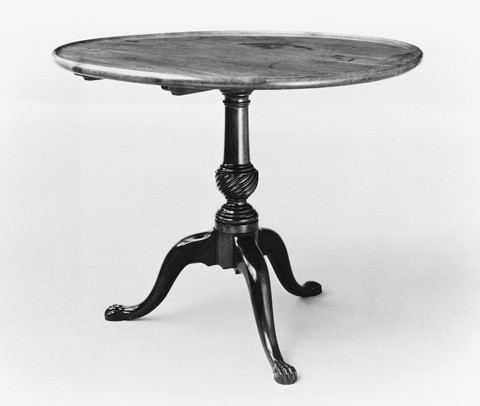
Tea table by John Goddard, Newport, Rhode Island, 1773. Mahogany and maple; iron. H. 26 1/2", Diam. 33". (Photograph, courtesy, John Nicholas Brown Center for the study of American Civilization, Brown University.)

Receipt from John Goddard to James Atkinson, December 9, 1773. (Photo, John Nicholas Brown Center for the Study of American Civilization, Brown University.)

Tea table attributed to Job Danforth, Providence, Rhode Island, ca. 1775. Mahogany and oak; iron. H. 27", Diam. 34 7/8". (Courtesy, Rhode Island Historical Society, gift of J. Danforth Edwards; photo, Gavin Ashworth.)

Tea table, Newport, Rhode Island, 1755–1775. Mahogany, cherry and maple; brass and iron. H. 26 5/8", Diam. 32 3/8". (Courtesy, Rhode Island Historical Society, gift of the Wunsch Americana Foundation.)
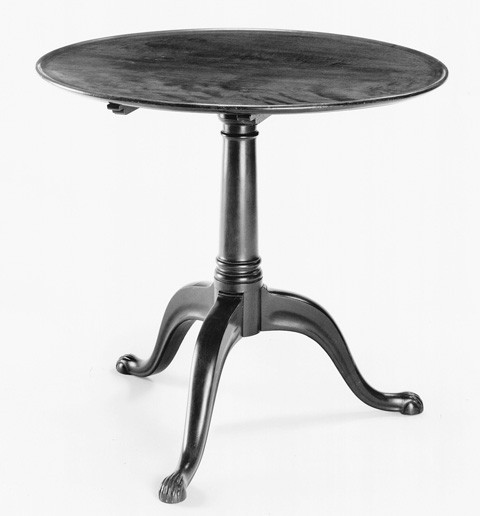
Tea table, Newport, Rhode Island, 1755–1775. Mahogany and maple; brass and iron. H. 28", Diam. 31 3/4". (Courtesy, Society for the Preservation of New England Antiquities, gift of Emma Franklin Estabrook.)

Tea table, Newport, Rhode Island, 1755–1775. Mahogany and maple; brass. H. 29 11/16", Diam. 33 3/8". (Private collection; photo, Israel Sack, Inc.)
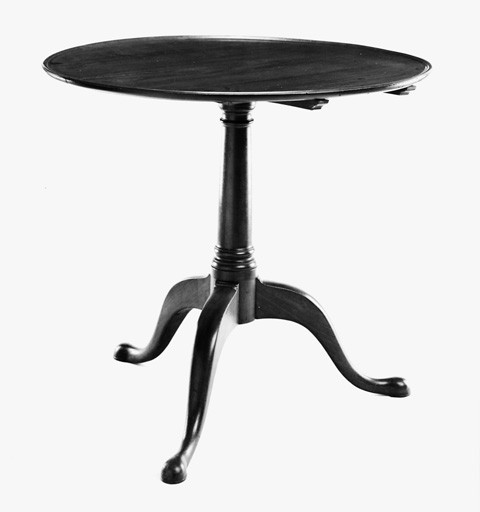
Tea table, Newport, Rhode Island, 1755–1775. Mahogany; brass. H. 27 15/16", Diam. 31 1/2". (Private collection; photo, David Bohl.)

Peter Harrison, Redwood Library, Newport, Rhode Island, 1748. (Photo, Gavin Ashworth.)
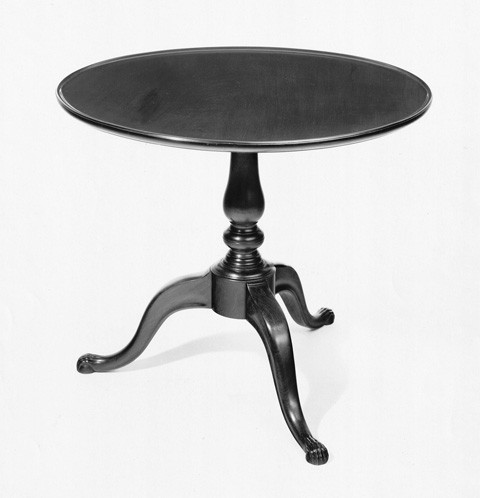
Tea table, Newport, Rhode Island,
ca. 1765. Mahogany and soft maple; brass and iron. H. 26 5/8", Diam. 31 7/8". (Private collection; photo, Israel Sack, Inc.)
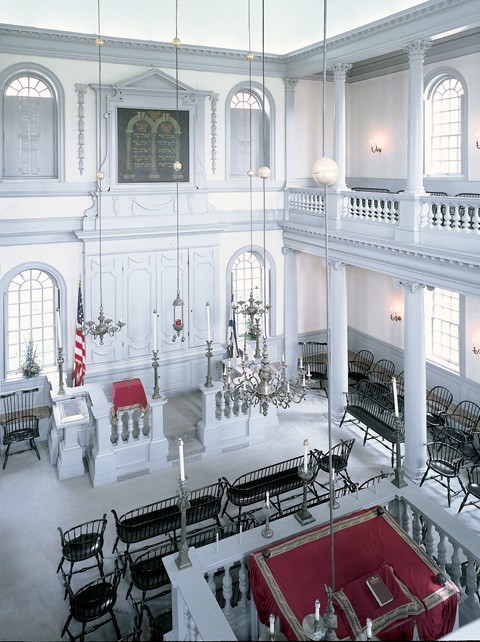
Interior view of the Touro Synagogue, Newport, Rhode Island, 1763. (Photo, Gavin Ashworth.)
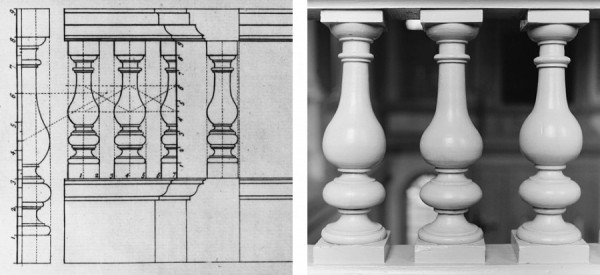
Comparative detail showing (left) designs for balusters and balustrades on pl. 17 of James Gibbs, Rules for Drawing, 1732, and (right) gallery balusters in the Touro Synagogue. (Courtesy, Printed Book and Periodical Collection, Winterthur Museum Library.)
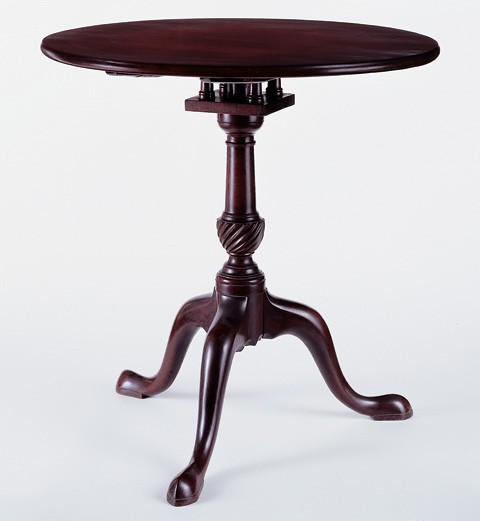
Tea table, Newport, Rhode Island, 1755–1775. Mahogany; brass. H. 27", Diam. 28 1/4". (Courtesy, Newport Historical Society; photo, Gavin Ashworth.)

Tea table, Newport, Rhode Island, 1755–1775. Mahogany and birch; brass. H. 27 5/8", Diam. 30 3/16". (Private collection; photo, Israel Sack, Inc.)
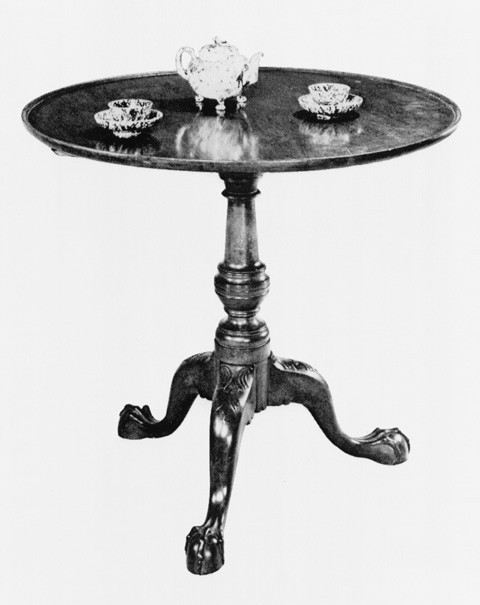
Tea table, Newport, Rhode Island, ca. 1765. Mahogany. (Advertised by Ginsburg & Levy, Inc., Antiques, May 1970.) www.themagazineantiques.com

Tea table, Newport, Rhode Island, 1755–1775. Mahogany and maple. H. 28", Diam. 32". (Courtesy, Rhode Island Historical Society.) Illustrated in Joseph K. Ott, The John Brown House Loan Exhibition of Rhode Island Furniture (Newport: The Rhode Island Historical Society, 1965), plate 33.
Tables with tilting tops and tripod bases became increasingly popular in England and her North American colonies during the second quarter of the eighteenth century, in conjunction with the fashion of drinking tea. Several elements of this table form were turned on a lathe, including the top and its supporting pedestal, or “pillar,” as it was called in that period. This article examines the manufacture and design of Rhode Island tripod-based tea tables and discusses the tradesmen who made these forms and sold component parts to other furniture makers.
The table illustrated in figure 1 is the only Newport example to survive accompanied by its original bill of sale. On December 9, 1773, Newport joiner John Goddard (1723–1785) charged James Atkinson (d. 1806) £3 for a mahogany “Fly Tea Table” (fig. 2). Other eighteenth-century terms for this form include “claw table” or “pillar and claw table.”[1]
The fly tea table has three serpentine-shaped legs with either snake, paw, or claw-and-ball feet that support a turned columnar pillar and a round top two to three feet in diameter. The top pivots from a vertical position when the table is stored to a horizontal position secured by a metal catch when the table is in use. The tops of these tea tables are often turned or shaped with a lip to prevent fragile ceramic tea wares from slipping over the edge. On Rhode Island tables, the pivot device is usually part of a stationary block. Fly tea tables were assembled so that the tripod base was oriented either to be conveniently stored in a corner or against a wall. On those intended to stand in a corner, an angle formed by two of the three legs is centered on the pintel edge of the block so that, on the backside, the third leg points into the corner. On those tables intended to stand against a wall, one of the three legs is oriented at right angles to the pintel edge of the block so that on the backside the other two legs splay, allowing the table to be placed close to a wall. Since this key decision in assembling the table affects how the table was intended to be stored and displayed, this option presumably was one presented to the customer.
The mechanical aspect of this tilting form placed unusual demands upon the engineering skills of the makers. The pintel hinge fashioned at one end of the stationary block had to bear a great weight when the top was moved to the vertical position for storage. Fly tea tables were a fragile and awkward form to move about the room. Their precariousness is documented by charges for their repair. In 1764, Newport joiner Job Townsend, Jr., charged merchant Matthew Cozzens 35s for “Making a new Top to a Fly Table.” This table may have been the same one that Townsend made for Cozzens seven years earlier. Newport joiner James Taylor debited John Cranston 3s for “Making new Cap Fly Table” in 1786, the same year Providence joiner Walter Nichols charged Isaac Senter 4s for the same service. These makers were probably mending the stationary block whose pintel hinge bore the wear-and-tear of the table’s moving parts. Nichols repaired Senter’s fly table again in 1795. In 1767, Townsend debited Archimedes George 12s for “making a Top to a Table & Slings for the same.” “Slings” was a contemporary term for cleats, and in this context they imply a round top. If Archimedes George was replacing a tea table top, the original might have been another casualty of this precarious form.[2]
Tilt-top tea tables are a triumph of the craft of turning. It takes considerable skill to manipulate a flat disk almost three feet in diameter on the face plate of a lathe. The steps typically involve truing the roughly sawn edge, cutting away the wood at the center so that the edge stands in relief, and turning the edge moldings. In Mechanick Exercises, or the Doctrine of Handy-Works Applied to the Arts of Smithing, Joinery, Carpentry, Turning, Bricklaying (1678) Joseph Moxon described the process of “Turning Flat Boards” and warned, “this Craft of the Hand must be acquired with some continued Use and Practice, which will better inform your Judgment what Errours you may be subject to commit, than many words.” The expertise involved in the production of the tops and pillars of these tables suggests that only furniture makers with consummate abilities at the lathe were responsible for this form.[3]
The earliest documentation for the manufacture of fly tea tables in Rhode Island is in Job Townsend, Jr.’s, ledger/daybook, which spans the years 1750–1778. During that time he recorded making fifteen fly tables for various members of the Newport community, the earliest in August 1757 for Matthew Cozzens. The following December, Townsend made one for Newport merchant Isaac Elizer, who ordered an additional example five months later. The patronage for Townsend’s tables grew after Joseph Wanton (1705–1780) purchased one in January 1762. Wanton, whose father, uncle, and cousin each had been governors of the Rhode Island Colony, would himself be governor from 1769–1775. His prominent social position apparently allowed him to set a style that others in the community were quick to follow. Four months after Wanton’s acquisition of a fly tea table, Robert Elliott purchased one. The following year wealthy Newporters avidly followed Wanton’s example.
A third of Townsend’s total output of fly tea tables was made in 1763. His patrons included Elinor Fickes, innkeeper John Lawton (d. 1783), merchants Samuel MacCalpin and Samuel Brenton, and shoemaker Nathan Luther. The cost of mahogany tables increased from 65s in 1762, to 70s in early 1763, to 75s by late spring, to 80s by the fall of that same year. Because Luther chose a more modest wood, fustick, he paid 25 percent less, or 60s, for his table in the fall of 1763.
Following this highpoint in the wake of Wanton’s purchase, Townsend recorded making only one or two fly tables a year in the next few years, including examples for mariner Solomon Townsend (d. 1770) in 1764, George Cornell (d. 1786) and Samuel Brenton in 1765, and Joseph Gardner (d. 1788) and Benjamin Wright (d. 1795) in 1766. Throughout those years the price remained at 80s until the fall of 1766 when Benjamin Wright paid 75s for a fly tea table. The final example that Townsend recorded making was for merchant William Rogers (d. 1772) in 1769, and the price had fallen to 70s. None of these tables made by Job Townsend have been identified.[4]
In addition to Townsend, Newport joiners Benjamin Baker and James Taylor and Providence chairmaker Job Danforth (1745–1838) made fly tea tables. In 1762, Baker made a mahogany example for Newport goldsmith Jonathan Otis. James Taylor debited Nathan Hart for a “fly table with claw feet” in 1772 and made a mahogany example for Jonathan Myrick in 1786. In his large production of tables, Job Danforth recorded making only one fly table, a cherry example for Stephen Abbott in 1791. A mahogany table that descended in Danforth’s family has been attributed to him (fig. 3). This table has peculiarities and relates to no others in the study, perhaps because Danforth rarely made this form. Its top has the largest diameter among the tables, and its ineptly proportioned pillar is unconventional in its lack of classical moldings; moreover, the pillar’s wide overhang where it meets the legs is ungainly. Among the five Rhode Island furniture makers known to have produced fly tables, Job Townsend made them with more regularity than did any other.[5]
All of these craftsmen, as well as Providence chairmakers William Barker and William and Samuel Proud, were accomplished turners who supplied other makers with components that probably included parts for fly tables. Townsend made pillars for Gideon Lawton and Josias Lydon. In 1766, he charged Samuel Lydon 10s for “Turning . . . a Table Top & Smouthing it of[f].” Like Townsend, Benjamin Baker turned parts from which other furniture makers could have assembled fly tea tables. For instance, he turned two pillars and fixed legs in one fly tea table for joiner Walter Nichols. William Barker and Samuel Proud also turned numerous pillars for other furniture makers. Barker made pillars for Samuel Mays, Stephen Carpenter, John Carlile, John Power, Nicholas Bragg, and Gershom Carpenter. Samuel Proud turned a pillar for Jonathan W. Coy and Joseph Martin in 1780. Although some furniture makers who purchased turned parts owned lathes, most probably did not. Additional documentary evidence underscores a pattern of interdependence and specialization. The account book of Newport joiner John Cahoone shows that he sold components to other furniture makers, but turned work was not among them. From these documents we can conclude that furniture makers with expertise at turning were responsible either for making Rhode Island fly tea tables or for supplying the requisite parts. Clearly, the beginnings of specialization among furniture makers was well established in Newport and Providence in the last half of the eighteenth century[6]
Among the Newport tables, one type stands out as a product created by furniture makers for local patrons as well as for venture cargo. The standard Newport fly tea table has a columnar pillar supported by serpentine legs ending in snake or very small paw feet. The serpentine legs on these tables are plain with no shaping on the undersides where they meet the pillar, although the sides of some of the legs have shallow indentations. Eleven examples of this form have been identified. One has a history of ownership by John Brown (fig. 4), another is in the collection of the Society for the Preservation of New England Antiquities (fig. 5), a third has a history of descent in the Brownell family of Westport, Massachusetts (fig. 6), and a fourth is in a private collection (fig. 7). An example that descended in the family of Joshua G. Wright of Wilmington, North Carolina, probably was shipped as venture cargo. Six tables of this type have appeared in the marketplace, one of which has a history of ownership by Captain Joseph Allen of Newport.[7]
This standard table traditionally has been attributed to John Goddard; however, differences in workmanship among the four tables examined and the six studied through photographs suggest that they were made by more than one individual or shop. All the cleats that attach the tops to the block atop the pillars are stepped in the regional style of Newport, but the shape of each pair of cleats is different. Likewise, different types of joints were utilized for connecting the base and the legs. The varying proportions of the moldings on the pillars and the several methods used to attach the tops to the lathe support the notion that these components are by different turners. In other words, the general concept of the tables share enough similarities to be identified as a regional type, but the idiosyncrasies of workmanship indicate that a number of individuals produced them or the parts for them.[8]
The standard type Rhode Island tea table was created within the larger cultural context particular to Newport and its distinctive embrace of the classical style. The columns—with their bases composed of a quarter-round, a cavetto, and another quarter-round, and their capitals defined by a quarter-round, a fillet, a cavetto, and torus—are interpretations of the Doric order. In the colonies, this order first appeared in Newport architect Peter Harrison’s designs for the Redwood Library, a wooden, rusticated, Roman Doric temple built in 1748 (fig. 8). This public building, which housed a library to which the leading citizens of the town belonged, introduced the classical style in American architecture.
Harrison’s architectural designs familiarized the residents of Newport with the current English Palladian style. It has been said that Harrison’s ability to adapt and interpret two-dimensional drawings from his extensive collection of English architectural books into three-dimensional reality placed Newport’s public buildings in the years after 1748 among the most advanced and academic in the colonies. Newport’s architectural heritage is indebted to Harrison, and by extension some credit must go to him for these tables. The balance and restraint of Harrison’s buildings are echoed in the tripod bases of the tables. Whereas many tripod-based tables have legs with cusps or serpentine profiles on their lower edges near the juncture with the pillar (see fig. 1), standard Newport tables are more restrained in omitting this detail. Newport residents embraced the classical style, as an affirmation of their position as educated individuals who were aware of the noble models provided by the ancient world and the qualities of temperance, stateliness, and harmony denoted by them.[9]
A further debt to Harrison is evident in the unusual and perhaps unique tea table shown in figure 9. The turner who made the pillar for the tea table may also have turned the balusters for Newport’s Touro Synagogue, designed by Harrison and dedicated in 1763. The balustrade of the gallery for the women in the congregation has balusters (fig. 10) that closely resemble the pillar of this tea table, with its large ogee form above a compressed ball. In designing the synagogue, Harrison again turned to his architectural books. For the balustrade he drew upon James Gibbs’s Rules for Drawing (fig. 11, 11b). The patron for this tea table may have been a member of the congregation who, inspired by the synagogue’s interior details, commissioned a table with a baluster in the latest fashion.[10]
Five Newport tables remain that can in varying degrees be associated with the architectural tradition of the town. Three have vase-shaped pillar turnings with carving that spirals in a manner similar to the bannisters in earlier baroque architecture, including the Sabbatarian Meeting House (built 1729). These tables include (1) the one John Goddard made for James Atkinson in 1773, (2) one that reputedly belonged to Solomon Southwick (1731–1797), publisher of the Newport Mercury (fig. 12), and (3) one with an ogee-shaped spiral pillar (fig. 13). Like the tables with the Doric columns, these examples were made by different shops. Many aspects of their fabrication are markedly different. The lip on the Goddard table was shaped by hand, the Southwick table (fig. 12) has no edge molding at all, and the top of the table shown in figure 13 is unusually thin and refined. The pillar of the Southwick table has a deep reel under the baluster and a steep pitch to the moldings below it. By comparison, the moldings on the pillar of the Goddard table are more compressed and the spirals are less vertical, and the animated spirals on the pillar of the example shown in figure 13 have an S-shape change in direction.[11]
A comparison of a pair of tables (figs. 13, 14) further illustrates the practice of acquiring component furniture parts from different sources. The tables illustrated in figures 13 and 14 share features, including tops with finely shaped lips and tripod bases with abstracted knee carving. On the other hand, the pillars for each table are distinctly different. From the visual evidence, it appears that, for this pair of tables, the same source supplied the tops, the same source supplied the bases, but a different source supplied the pillars. This pattern suggests interdependence and specialization among the shops that produced these objects. A final example, shown in figure 15, has a top with complex edge moldings, C-scroll silhouettes on the underside of the legs where they join the pedestal, open talon claw-and-ball feet, and pendant knee carving in the tradition of John Goddard.[12]
With their slender turned pillars as a counterpoint to the flat expanse of their richly grained tops, fly tea tables were a novel and dynamic form in eighteenth-century parlors. The 1779 estate inventory of Matthew Cozzens reveals that his table (probably the one that Job Townsend, Jr., made for him in 1757) stood in the “Great Room” along with a clock, a looking glass, a mahogany table, a desk-and-bookcase, five leather-bottomed chairs, three roundabout chairs, and an easy chair. The tea table would have been at the hub of social gatherings of the immediate family and acquaintances from the outside world. The six china cups and saucers and a china teapot, milk pot, and canister also listed for the room would have been used upon it. As a focal point of social interchange in the home’s most luxurious setting, the tea table was emblematic of the taste and affluence of its owner.[13]
The tripod-based tea tables made in Rhode Island represent different stylistic modes available to colonials in the third quarter of the eighteenth century. Job Danforth’s account book shows that he rarely made the form, and his unconventional creation (fig. 3) exhibits all the peculiarities one might anticipate in the production of an unfamiliar form. The tables illustrated in figures 1 and 12–15 share elements with tables found elsewhere in the colonies. Their swirled pedestals, paw feet, and C-scrolls and serpentine shapes on the underside of the legs denote the whimsy and playfulness of the then prevailing rococo style. Among the Atlantic colonies the taste for classicism was developed to an extraordinary level in Newport through the architectural designs of Peter Harrison. This predilection for classicism in the public buildings of Newport extended into its domestic interiors. The table shown in figure9 apparently is unique, and its pillar bears close comparison to the balustrade in the women’s gallery in Harrison’s Touro Synagogue, which he derived from a plate in Gibbs’s Rules for Drawing. Like Harrison’s Redwood Library, the most common tripod-based Rhode Island tea tables, as illustrated in figures 4–7, were even closer to the classical tradition. The standard Rhode Island fly tea table with its Doric column pillar is a rare expression of the Palladian style in American furniture.
This table and its bill of sale were first illustrated in Ralph E. Carpenter, Jr., The Arts and Crafts of Newport, Rhode Island (Newport, R.I.: Preservation Society of Newport County, 1954), p. 107, fig. 79. When the table was sold in 1930 by Newport antiques dealer George E. Vernon, it was accompanied by an affidavit from the last family owner, Louisa F. Atkinson, that stated, “This will certify that the black birch chair and mahogany tea table together with the bill of sale for same signed by John Goddard were purchased from me and have always been the property of my family.”
Job Townsend, Jr., Ledger/Daybook, 1750–1793, Newport Historical Society, Newport, Rhode Island, vol. 504, p. 86. Joseph K. Ott, “Recent Discoveries Among Rhode Island Cabinetmakers and Their Work,” Rhode Island History 28, no. 1 (winter 1969): 8, 9. James Taylor Ledger, 1767–1802, Newport Historical Society, Newport, Rhode Island, vol. 498, p. 55. Job Townsend, Jr., Ledger/Daybook, p. 98.
Joseph Moxon, Mechanick Exercises or the Doctrine of Handy-Works Applied to the Arts of Smithing, Joinery, Carpentry, Turning, Bricklaying (1703; reprint edition, New York, Washington, London: Praeger Publishers, 1970), p. 209.
Job Townsend, Jr., Ledger/Daybook. The fly table transactions discussed can be found on p. 1 (Cozzens); p. 17 (Eliezer); p. 72 (Elliot, Wanton); p. 76 (Fickes); pp. 77–78 (Lawton, Luther); p. 79 (MacCalpin, Brenton); p. 80 (Townsend); p. 87 (Cornell); p. 92 (Brenton); p. 94 (Gardner); p. 95 (Wright); and p. 107 (Rogers). Brenton was charged twice by Townsend, but it is not clear if this was an accounting error or if Brenton purchased two tables. Luther’s table of fustick, or fustic, was probably made from the yellow wood of a common tropical American tree (Chlorophora tinctoria).
Benjamin Baker Account Book, 1761–1792, Newport Historical Society, vol. 1904, n.p. The charge was for “1 fly table of mehogni 70s” for the date November 15, 1762. James Taylor Ledger, Newport Historical Society; see page 3 for the charge to Hart of 80s for “a Fly Table Claw Foot” and page 54 for the charge to Myrick of 3s 12d for a “Fly Table Mahog.” Job Danforth Account Book, Carter-Danforth Papers, Rhode Island Historical Society, Providence, Rhode Island, p. 41. William M. Pillsbury, “Earning a Living 1788–1818: Job Danforth, Cabinetmaker,” Rhode Island History 31, nos. 2–3 (1972): 85, 93. The Danforth table has trapezoidal cleats, the block is of oak, and the pillar is clover shaped where it comes through the block. The lock device is large and made of iron.
Townsend turned large-scale work, including many sets of bedposts, sets of legs, bannisters, and stair ornaments, and small-scale work, including punch ladle handles (presumably to be fitted to silver bowls) and billiard balls. See Job Townsend, Jr., Ledger/Daybook, p. 90 (bedposts), p. 84 (stair ornaments), pp. 93, 96 (punch ladle handles), p. 112 (billiard balls), pp. 73–75 (sets of table legs). See also James Taylor Ledger. Taylor debited joiner Ebenezer Dunton for turned legs in 1768 (p. 2) and Timothy Waterhouse for turning a set of legs and bedposts in 1774 (p. 16). See also Benjamin Baker Account Book, n.p. Baker turned table legs for joiner Eleazer Trevett in October 1786 and clock case pillars for joiner Walter Nichols in July 1786. See William Barker Account Books, 5 vols., Rhode Island Historical Society. Among the furniture makers that Barker supplied with turned parts were Philip Potter and Samuel Mays, for whom he turned legs, feet, and drops among other things (vol. 1, pp. 10 recto, 13 verso, 14 verso, 17; vol. 2, p. 11 verso, p. 14 recto). See William and Samuel Proud Ledger, Rhode Island Historical Society. Among the accounts of William Proud between 1773 and 1779 are transactions with Joseph Martin for turned sets of bedposts and legs, including legs for a high case of drawers (pp. 1, 8). Proud also made sets of table legs for Daniel Martin (p. 18). Job Townsend, Jr., Ledger/Daybook. See page 73 where Townsend records a pillar made for Gideon Lawton in 1762 (2s) and page 95 where he recorded charges for a pillar for Josias [?] Lydon in 1766 (4s).
John Bivins, “A Catalog of Northern Furniture with Southern Provenances,” Journal of Early Southern Decorative Arts 15, no. 2 (November 1989): 60–61. This table subsequently was offered for sale (seeAntiques 142, no. 1 [July 1992]: 41). See Christie’s, Important American Furniture, Silver, Folk Art and Decorative Arts, New York, January 18, 1997, lot 252, for the table that descended in the family of Captain Joseph Allen. See also Christie’s, Fine American Furniture, Silver, Folk Art and Decorative Arts, October 21, 1989, lot 389; Christie’s, American Furniture, Silver, Folk Art and Decorative Arts, June 25, 1991, lot 197; Christie’s, Important American Furniture, Silver, Folk Art and Decorative Arts, June 21, 1995, lot 220; Christie’s, Important American Furniture, Silver, Folk Art and Decorative Arts, June, 18, 1998, lot 135 and reoffered at Christie’s, Important American Furniture, Folk Art and Decorative Arts, October 8, 1998, lot 52. See also Sotheby’s, Important American Furniture and Related Decorative Arts, January 27 and 29, 1983, lot 304.
The similarity of the carved paw feet on some of these tables and the feet on a tea table in the Karolik Collection at the Museum of Fine Arts, Boston, that has a history of having been made by John Goddard for his daughter Catherine provides the basis for the traditional attribution of this form to John Goddard. Edwin J. Hipkiss, Eighteenth-Century American Arts: The M. and M. Karolik Collection (Cambridge: Harvard University Press for the Museum of Fine Arts, Boston, 1950), pp. 110–11. In a note, Hipkiss cites Duncan A. Hazard who stated in 1929, “The table was made by John Goddard and presented to his daughter Catherine who married Perry Weaver. . . . I purchased it of the estate of Miss Susan J. Weaver” (Goddard’s great, great-granddaughter). On the Society for the Preservation of New England Antiquities (SPNEA) table (fig. 5), the cleats extend beyond the incised line cut in the underside of the top. The tips of the cleats have a quarter-round profile; the outermost steps are quarter-rounds; the innermost steps, at the block, are serpentine curves. On the table illustrated in Christie’s, Important American Furniture, October 8, 1998, lot 52, the cleats also extend beyond the incised line cut in the underside of the top. The tips of the cleats have a serpentine profile; the outermost steps are quarter-rounds, and the innermost steps, at the block, are serpentine curves. On the Rhode Island Historical Society (RIHS) table (fig. 4), the cleats are set in about an inch from the incised line on the underside of the edge of the top. The tips of the cleats are rounded; an elongated serpentine curve extends from the tips to the higher section of the cleats at the block. On a table in a private collection (fig. 6) the tips of the cleats are set in about an inch from the incised line on the underside of the edge of the top. The tips of the cleats have a serpentine profile; the steps near the block have a serpentine profile (Philip and Ann Holzer Collection [privately printed, 1990], cat. no. 8A.) On the table in the private collection (fig. 7) the cleats extend beyond the incised line cut in the underside of the top. The tips of the cleats and the steps near the block have a serpentine profile. On all these tables the block at the top of the pillar is deeper than the cleats. The table in figure 5 and the table in a private collection (fig. 7) have a one-piece iron brace nailed and screwed to the joint of the legs and pillar. The table in Christie’s, Important American Furniture, October 8, 1998, lot 52, and the table in figure 4 each have a three-part iron brace. The brace on the table in figure 4 is nailed, and the legs are not gouged. The table in figure 6 has no brace. Furthermore, the shoulders on the legs on either side of the dovetails on the table in figure 5 and the table in figure 6 are curved to conform to the circumference of the pillar. On the table in figure 4 and the table in a private collection (fig. 7) the shoulders are at right angles to the dovetails, and the sides of the pillar have been flattened to conform to the shoulders. Stand and table tops frequently were attached to a lathe in order to shape the molded edge, remove excess wood between the edges, and incise the underside of the top near the edge. Joseph Moxon’s Mechanick Exercises (p. 189) describes broad flat mandrels with three or more iron pins that are attached to the backside of flat boards that are to be turned. Only the Job Danforth table (fig. 3) has a series of holes near the centerpoint on the backside of the top, suggesting that he may have used such an attachment tool. Another lathe attachment a turner could use to work flat boards was an arbor and iron cross. See Charles Hummel, With Hammer in Hand: The Dominy Craftsmen of East Hampton, New York (Charlottesville: University Press of Virginia for the Henry Francis du Pont Winterthur Museum, 1968), pp. 90–91. Hummel states that the arbor and cross is the most important lathe attachment to survive from the Dominy shop because no eighteenth- or nineteenth-century English or French sources illustrate this equipment. He concludes that either it was so commonly known to turners that it was overlooked in the manuals or that it was an American solution to the problem of turning table tops. The iron cross had holes in it through which the turner could secure his slab of wood. The supposition used in this study is that the predetermined size of the cross and spacing of the holes in it should allow one to determine if a table top was fabricated using the same attachment. The tops of the five tables examined (figs. 4–7 and Christie’s, Important American Furniture, October 8, 1998, lot 52) exhibit no similar patterns. The table in figure 5 has approximately fourteen holes going around almost the entire circumference about four inches in from the edge. They are from 11" to 12 11/16" from the centerpoint. The Christie’s table has four pairs of holes about four to six inches apart. The table in figure 4 has five holes; four are outside the cleats from 11 1/2" to 11 7/8" from the centerpoint; a fifth is between the cleats below the block when the table is tilted up, making its distance from the centerpoint impossible to determine. The table in figure 6 has four holes; two are close to one another and are 10 11/16" and 10 13/16" from the centerpoint; two are far apart and are 10 15/16" and 11 3/8" from the centerpoint. The table in figure 7 has nine holes from 10 7/8" to 11 1/8" from the centerpoint.
Antoinette F. Downing and Vincent J. Scully, Jr., The Architectural Heritage of Newport, Rhode Island, 1640–1915, 2d rev. ed. (New York: Clarkson N. Potter, Inc., 1967). In chapter five, Downing discusses Harrison’s career and draws upon the previous research presented in Fiske Kimball, “Colonial Amateurs and Their Models: Peter Harrison,” Architecture 53, no. 6 (June 1926): 155–60; Architecture 54, no. 1 (July 1926): 185–90, 209; and Carl Bridenbaugh, Peter Harrison, First American Architect (Chapel Hill: University of North Carolina Press, 1949).
Although it is unusual, this tea table can be identified as a Newport product on the basis of the paw feet, the shallow indentations on the sides of the legs, the stepped cleats, and the stationary maple block. The construction of the pedestal sets this table apart from standard Newport products. The pillar rests upon a separate round element into which the legs are dovetailed. Downing and Scully, Architectural Heritage of Newport, pp. 85, 58–59.
The table illustrated in figure 12 is the only one in the study that has a birdcage at the top of the pillar. The cleats on that table and the one shown in figure 13 are trapezoidal, which is also atypical for Newport. The cleats on the table shown in figure 1 are stepped with serpentine curves at the tips and quarter-round profiles at the block. Unlike the tables with Doric columns, the block is not deeper than the cleats.
For a discussion of pendant carving attributed to John Goddard, see Michael Moses, Master Craftsmen of Newport, The Townsends and Goddards (Tenafly, N.J.: MMI Americana Press, 1984), pp. 210–11.
Estate inventory of Matthew Cozzens, 1779, William Ellery Collection, Rhode Island Historical Society, series 2, folder 10. The older furniture, the “old Desk” and six “old Chairs,” were in the other sitting room.
